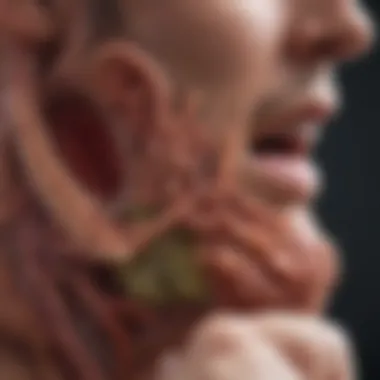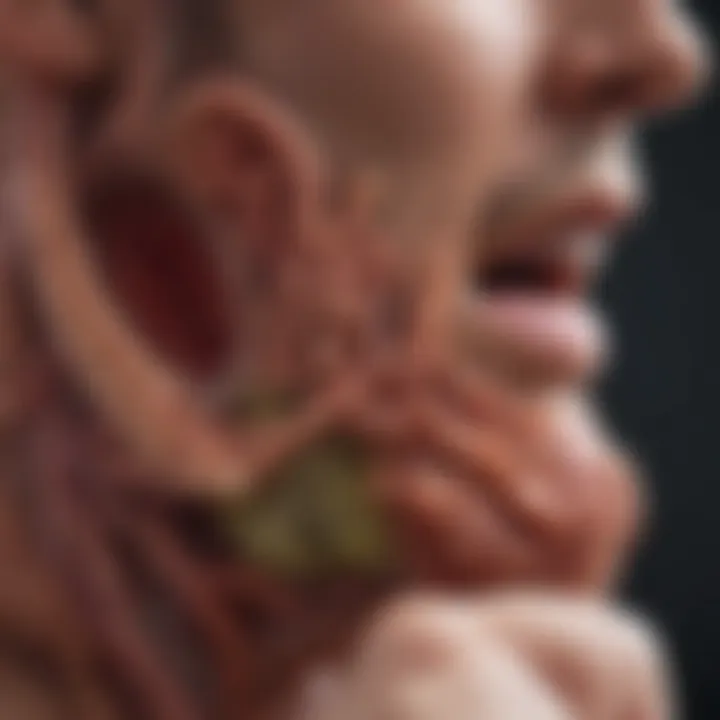Chronic Coughing with Phlegm: Causes and Treatments


Intro
Chronic coughing with phlegm is a complex and prevalent issue affecting countless individuals. This condition, often seen as a symptom rather than a standalone ailment, can be the result of various factors. Understanding its roots is crucial for effective treatment and management.
In this examination, the focus will traverse into the diverse causes of chronic cough with phlegm, including infections, allergies, and chronic diseases. We will also review the diagnostic methods currently in use and explore viable treatment strategies. This potentially transformative insights aim to enhance the quality of life for those afflicted and pave the way for future research.
Recent Advances
Latest Discoveries
Recent research has unveiled significant findings regarding the role of certain respiratory infections in chronic coughing. Studies have demonstrated that viruses, particularly the influenza virus and rhinovirus, can instigate prolonged mucus production, leading to persistent symptoms. Moreover, the association between gastroesophageal reflux disease (GERD) and chronic cough is becoming increasingly recognized. A growing body of evidence indicates that stomach acid irritation can cause throat inflammation and provoke cough reflexes.
Another critical development involves identifying the impact of environmental factors, such as air pollution, on respiratory health. Research has shown that exposure to particulate matter can exacerbate coughing and mucus production in sensitive individuals. Patients with preexisting conditions, such as asthma or chronic obstructive pulmonary disease (COPD), might experience more pronounced symptoms in polluted environments.
Technological Innovations
Advancements in diagnostic tools have also played a role in examining chronic cough. Techniques like high-resolution computed tomography (HRCT) scans and bronchoscopy enable physicians to visualize airway obstructions and inflammatory changes more clearly. Consequently, these technologies provide an improved understanding of the condition, allowing for more tailored interventions. The development of digital health applications may also contribute to effective self-management strategies, giving patients the ability to track their symptoms and treatment response.
Methodology
Research Design
An integrated approach is vital for understanding chronic cough with phlegm. This article draws from a combination of retrospective cohort studies, randomized controlled trials, and systematic reviews. These methodologies enhance both the reliability of results and the way information is synthesized. For instance, systematic reviews allow for insights across multiple studies, elucidating patterns that may not be apparent in single-institution research.
Data Collection Techniques
Data collection for this analysis included both quantitative and qualitative methods. Patient interviews and symptom diaries were conducted to gather first-hand accounts of experiences living with chronic cough and phlegm. Additionally, epidemiological data from health records and public health databases provided a broader view of prevalence and associated factors. The synthesis of these various data types allows for a well-rounded understanding of the issue.
Understanding Chronic Coughing
Understanding chronic coughing is crucial in comprehending the broader context of respiratory health. Chronic cough is more than just a nuisance; it often signals underlying health issues that may require attention. In this article, we will elucidate the significance of chronic coughing, especially when accompanied by phlegm, which is frequently indicative of various medical conditions.
Definition and Classification
Chronic cough is defined as a cough that lasts eight weeks or longer. It can be classified into different categories based on its characteristics and associated symptoms. The classifications include:
- Acute Cough: Lasts less than three weeks, often due to infections.
- Subacute Cough: Lasts between three to eight weeks, typically arising from a lingering infection.
- Chronic Cough: Persists beyond eight weeks and usually indicates a more serious underlying condition.
Chronic coughing with phlegm usually involves mucus production. This type of cough may be linked to respiratory diseases. The classification helps in determining the appropriate diagnostic and treatment measures, which is paramount for effective management.
Epidemiology and Prevalence
Chronic coughing with phlegm impacts a significant portion of the population. Research indicates that about 10-20% of individuals experience chronic cough. It is particularly prevalent among older adults and those with preexisting respiratory conditions, such as Chronic Obstructive Pulmonary Disease (COPD) or asthma.
Several factors can influence the prevalence of chronic cough with phlegm, including:
- Environmental Exposures: Pollutants and allergens.
- Smoking and Tobacco Use: Major contributors to respiratory issues.
- Occupational Hazards: Certain professions expose workers to irritants that can lead to chronic cough.
Understanding the epidemiology of chronic cough can shed light on public health implications. By recognizing who is affected and the broader impacts, health care providers can tailor interventions more effectively.
Phlegm Production: An Overview
Phlegm production is a key element in understanding chronic coughing. It serves multiple roles in the respiratory system and aids in maintaining airway health. By diving into the processes that govern phlegm production, one can gain insight into how various conditions can cause excessive coughing alongside mucus. This overview sheds light on relevance of normal phlegm production and the circumstances under which it becomes problematic.
Physiology of Mucus Secretion
Mucus secretion is a fundamental physiological process. Goblet cells and submucosal glands in the airway epithelium are primarily responsible for producing mucus. The composition of mucus includes water, glycoproteins, lipids, and various antimicrobial peptides that contribute to its properties. The secretion is regulated through neuronal and hormonal signaling pathways.
When exposed to irritants, allergens, or pathogens, mucus secretion increases as a defense mechanism. This phenomenon is crucial in preventing pathogens from entering the body, thus functioning as an important barrier. However, overproduction of mucus can lead to complications. Conditions like asthma can trigger hyperreactivity, causing persistent mucus production, leading to chronic coughing.
Role of Mucus in the Respiratory System
Mucus has several critical roles in the respiratory system. Its primary function includes trapping foreign particles and microorganisms that enter through inhalation. By adhering to these unwanted elements, mucus helps facilitate their removal through ciliary action. Furthermore, mucus plays a role in hydration of the airway surface, maintaining overall respiratory health. It allows for proper gas exchange by ensuring that the airways remain moist.
Additionally, the antimicrobial properties of mucus help in neutralizing pathogens. It contains substances like immunoglobulin A, which helps in immune defense. In the context of chronic coughing, understanding this role illuminates why excess phlegm can be problematic. The balance between protective mucus production and excessive mucus can directly impact the quality of life.
In summary, phlegm production is not merely an inconvenience but a critical function that reflects the state of the respiratory system. By understanding the physiology of mucus secretion and its roles, we can better grasp the complexities of chronic coughing with phlegm.
If you want to explore more about mucus physiology, check out Wikipedia.
Common Causes of Chronic Cough with Phlegm
Understanding the common causes of chronic coughing with phlegm is crucial. This condition significantly affects individuals’ daily lives. Identifying these causes can lead to more effective treatment and management strategies. The discussion includes infectious agents, allergies, chronic diseases, and lifestyle factors. Each element plays a unique role in mucus production and cough reflex.


Infectious Causes
Bacterial Infections
Bacterial infections are a leading cause of chronic cough with phlegm. These infections typically result from pathogens such as Streptococcus pneumoniae. They often manifest with persistent respiratory symptoms, including increased mucus production. The signature characteristic of these infections lies in the nature of the phlegm, which may appear green or yellow, indicating infection. Compared to other causes, bacterial infections can often be treated effectively with antibiotics. Their identification is essential as improper treatment can prolong symptoms and lead to complications.
Viral Infections
Viral infections are another common source of chronic cough with phlegm. They include viruses like influenza and rhinovirus, which can infect the airways. A key characteristic of viral infections is the gradual onset of symptoms, including a cough that may linger long after other symptoms have subsided. Unlike bacterial infections, antiviral medications are limited. Most viral infections resolve with supportive care. This nature of viral infections contributes to the complexities of managing chronic cough since symptoms can vary dramatically from patient to patient.
Fungal Infections
Fungal infections, such as those caused by Aspergillus species, can also lead to coughing with phlegm. These infections are less common but significant in immunocompromised individuals. The key feature is the thick, often difficult-to-clear mucus that accompanies the infection. Fungal infections require specific antifungal treatments, highlighting their unique place in chronic cough discussions. Understanding these infections helps health professionals distinguish them from bacterial or viral causes, affecting treatment decisions.
Allergies and Environmental Triggers
Dust and Pollutants
Dust and common pollutants are important contributors to chronic cough. They irritate the respiratory tract, leading to increased mucus production. Dust mites, for example, can be a major trigger for those with allergies. One significant aspect is how environmental factors often set off symptoms in predisposed individuals. The unique feature of dust and pollutants is that they are manageable through lifestyle changes, such as regular cleaning and use of air purifiers. However, the prevalence of these irritants in urban environments poses challenges for effective management.
Pollen and Pet Dander
Pollen and pet dander are well-known allergens that incite coughing and phlegm. These triggers vary by season, affecting individuals differently. Their key characteristic is their ability to elicit immediate allergic responses, leading to excess mucus production. Understanding the role of these allergens is beneficial, as it guides individuals in controlling their environment. Through measures like using hypoallergenic bedding or implementing air filters, one can often alleviate symptoms. The difficulty lies in completely avoiding exposure, especially for those living with pets or in areas with significant pollen counts.
Chronic Respiratory Diseases
Chronic Obstructive Pulmonary Disease (COPD)
Chronic Obstructive Pulmonary Disease significantly contributes to chronic cough with phlegm. COPD includes conditions like chronic bronchitis and emphysema. A key characteristic is the persistent airflow limitation due to lung inflammation, leading to chronic mucus production. Patients often experience exacerbations, which can worsen their symptoms. This aspect proves crucial in understanding the disease's burden on quality of life. Early diagnosis can dramatically improve management outcomes for COPD patients.
Asthma
Asthma is another critical factor in chronic coughing with phlegm. It is marked by airway hyper-responsiveness and inflammation. The hallmark of asthma is the episodic nature of symptoms, which may include wheezing, chest tightness, and phlegm. Managing asthma often requires a comprehensive strategy, including inhalers and lifestyle modifications. Understanding asthma’s dual nature, as both an allergic and non-allergic condition, is essential in formulating effective treatment strategies.
Bronchiectasis
Bronchiectasis is characterized by abnormal and permanent widening of the bronchi. It often stems from previous infections or underlying conditions. In individuals with bronchiectasis, chronic cough and excessive phlegm are predominant features. The mucus produced is often thick and can lead to severe complications if not managed appropriately. Recognizing bronchiectasis is vital, as it requires a multifaceted treatment approach, often involving antibiotics, physiotherapy, and even surgery in extreme cases.
Gastroesophageal Reflux Disease (GERD)
Gastroesophageal Reflux Disease can trigger chronic cough with phlegm. This occurs when stomach acid flows back into the esophagus, irritating the throat. The cough can be chronic and accompanying phlegm may appear clear or mucoid. This condition can often be overlooked as a cause of chronic coughing. Proper management typically involves lifestyle modifications and medications to reduce acid reflux symptoms. Understanding GERD’s role in cough symptoms is essential for comprehensive treatment planning.
Smoking and Tobacco Use
Smoking and general tobacco use is a central contributor to chronic coughing. It damages lung tissue, leading to increased mucus production. The characteristic smoke can irritate the respiratory system and exacerbate underlying conditions such as COPD. This association emphasizes the importance of smoking cessation programs. Successfully quitting smoking can lead to improved respiratory health and a significant reduction in cough and phlegm production. Addressing tobacco use patterns is a key aspect of making long-term improvements.
Diagnostic Approaches
Accurately diagnosing chronic coughing with phlegm is critical for determining its cause and appropriate management. The diagnostic process typically involves gathering a detailed patient history alongside various clinical examinations and laboratory tests. A thorough assessment ensures that healthcare providers have a comprehensive understanding of the patient's condition, ultimately improving the chances of successful treatment.
Clinical History and Physical Examination
Evaluating a patient’s clinical history is foundational for diagnosing chronic cough. Physicians need to understand the duration and nature of the cough, associated symptoms, and any known triggers. Key questions include:
- When did the cough start?
- Are there periods of remission?
- Any accompanying symptoms like fever or chest pain?
- History of allergies or asthma?
A physical examination can provide immediate insights, such as checking for wheezing or other abnormal lung sounds. These preliminary steps enhance the accuracy of subsequent diagnostic tests.
Laboratory Tests
Laboratory tests play a vital role in diagnosing chronic coughing with phlegm. Two key types of tests include sputum analysis and blood tests, each offering unique insights into the patient’s respiratory health.
Sputum Analysis
Sputum analysis involves examining mucus coughed up from the lungs. It is necessary for identifying infections or abnormal cells. The key characteristic of this analysis is its ability to reveal the presence of bacteria, fungi, or other pathogens.
This form of analysis is beneficial as it can identify specific infectious agents, which allows for targeted treatment. However, sputum samples can be difficult to obtain effectively, especially in patients who do not produce enough mucus. Additionally, interpreting the results can require specialized knowledge.
Blood Tests
Blood tests are also essential in diagnosing chronic cough. They can help detect underlying conditions such as infections or allergies. Such tests often evaluate markers of inflammation and overall immune response.
The key aspect of blood tests is their ability to provide a broad profile of the patient's health status. This can lead to quick identification of potential underlying causes. However, blood tests can sometimes yield inconclusive results and may necessitate further testing, potentially delaying diagnosis.


Imaging Studies
Imaging studies form another crucial aspect of the diagnostic process. They help visualize structures of the respiratory system. Commonly employed techniques include chest X-rays and CT scans, which offer different levels of detail regarding lung health.
Chest X-Ray
Chest X-rays are typically the first imaging technique used. They help identify any obstructions, fluid accumulation, or structural abnormalities in the lungs. The primary benefit of a chest X-ray is its speed and accessibility, making it a common initial step in diagnosis.
However, while chest X-rays can reveal significant issues, they might not provide enough detail for more complex cases. Additional imaging may be necessary if abnormalities are detected.
CT Scans
CT scans provide a more detailed view than X-rays. They can identify subtle changes in lung tissues and help differentiate among various lung disorders. The key advantage of CT scans is their superior resolution, which can uncover issues that X-rays might miss.
Despite their benefits, CT scans involve higher radiation exposure and are generally more costly. This could limit their use as the initial imaging choice in many cases.
Impact on Quality of Life
Chronic coughing with phlegm is more than just a physical ailment; it carries significant consequences for daily living. Individuals affected often experience various challenges that extend beyond mere discomfort. Understanding the impact on quality of life can help caregivers and health professionals devise better management plans.
Physical Limitations
Physical limitations caused by chronic coughing with phlegm can be profound. Routine activities, such as walking or climbing stairs, may become strenuous. This condition can lead to reduced stamina and endurance, as coughing spells may interrupt physical exertion.
Additionally, the constant need to clear the throat can lead to discomfort and fatigue. In some cases, the production of phlegm may impede activities like exercise or social gatherings, further contributing to a sedentary lifestyle.
"Many patients acuteley feel the frustration of losing their normal activity levels due to chronic coughing."
Mental and Emotional Effects
The mental and emotional impacts of chronic coughing are significant. Patients often report feelings of anxiety and frustration. The uncertainty around the cause of their cough can lead to stress. This stress can impair concentration at work, disrupt sleep patterns, and lower overall mood.
Additionally, persistent coughing can lead to embarrassment in social settings, which creates a negative feedback loop, worsening mental health. Patients may withdraw from situations where they fear coughing might draw attention or provoke unwanted discussions about their health.
Social Interactions and Perceptions
Social interactions are heavily influenced by chronic coughing with phlegm. The societal stigma surrounding persistent coughs can alter perceptions. Friends and coworkers might view affected individuals differently. Misinterpretations can arise, leading to social isolation.
Moreover, coughing fits may occur unexpectedly, disrupting conversations and gatherings, leading to awkward moments. This can diminish one's confidence and willingness to engage in social activities.
In summary, the effects of chronic coughing with phlegm cascade through every aspect of life. Addressing these impacts requires a multi-faceted approach that considers both physical symptoms and emotional well-being.
Management Strategies
Management of chronic coughing with phlegm is vital for improving patient outcomes and overall quality of life. This section covers effective strategies to address the symptoms and root causes of the condition. The approach combines both pharmacological and non-pharmacological treatments, ensuring a comprehensive method tailored to individual needs.
Pharmacological Treatments
Expectorants
Expectorants are medications designed to help thin mucus in the airways, making it easier to cough up. The key characteristic of expectorants is their ability to facilitate the clearance of sputum. This is particularly beneficial for individuals suffering from chronic cough with phlegm, as it can significantly improve airway function and help reduce the frequency of coughing episodes.
One unique feature of expectorants is their action on the respiratory tract. They help to hydrate mucus, making it less viscous and easier to expel. However, while expectorants are generally safe, they may not address underlying infections or severe respiratory diseases. They should be used judiciously based on medical guidance.
Cough Suppressants
Cough suppressants are another class of pharmacological treatments that aim to reduce the urge to cough. Their key characteristic is their function to inhibit the cough reflex, providing short-term relief. This type of treatment is important in managing chronic cough, especially when the cough is disruptive and leads to sleep disturbances or significant discomfort.
A unique aspect of cough suppressants is their ability to provide immediate relief from chronic symptoms. Nevertheless, it's important to note that while they can alleviate symptoms, they do not resolve the underlying cause of coughing, such as infections or bronchial inflammation. Therefore, they are typically recommended for short-term use and under the guidance of a healthcare provider.
Antibiotics
Antibiotics play a crucial role when chronic cough is due to bacterial infections. The primary aspect of antibiotics is their ability to target and eliminate bacterial pathogens. In cases of chronic cough accompanied by phlegm, identifying any underlying bacterial infection becomes essential for effective management.
The unique feature of antibiotics is their targeted action against specific germs. Unlike other treatments, antibiotics address the root cause, leading to potential resolution of cough symptoms. However, misuse or overuse of antibiotics can lead to side effects and antibiotic resistance. Therefore, it is critical to use them only when prescribed by a healthcare professional.
Non-Pharmacological Approaches
Hydration and Humidification
Hydration and humidification are straightforward yet powerful non-pharmacological approaches. Maintaining adequate hydration helps keep mucus thin and easier to expel. Humidifiers add moisture to the air, which can soothe irritated airways and promote a healthier respiratory environment. This dual approach is practical and highly accessible, making it a popular choice for individuals managing chronic cough with phlegm.
A unique characteristic of this method is its non-invasive nature, allowing individuals to incorporate it into daily routines without the need for medications. Although generally safe, individuals should ensure that humidifiers are well-maintained to avoid the growth of mold or bacteria.


Respiratory Therapy
Respiratory therapy involves techniques and exercises aimed at improving lung function and reducing symptoms associated with chronic cough. This therapy can be highly beneficial for patients with chronic respiratory diseases.
The key feature of respiratory therapy is its focus on enhancing breathing efficiency and decreasing airway resistance. Techniques such as deep breathing exercises, guided cough methods, and flutter devices can significantly aid in symptom management. While this approach requires some time and commitment, it offers long-term benefits for lung health and overall respiratory wellness.
In summary, the management strategies for chronic coughing with phlegm emphasize a blend of pharmacological treatments and lifestyle changes. Understanding these strategies ensures informed choices, promoting better health outcomes for affected individuals.
Lifestyle Modifications
Lifestyle modifications play a crucial role in managing chronic coughing with phlegm. These changes not only aim to alleviate symptoms but also target the root causes of the condition. Such modifications can help reduce mucus production, improve lung function, and enhance overall quality of life. It is essential to recognize that integrating these adjustments involves a thoughtful approach, taking into account individual health needs and lifestyle habits.
Dietary Considerations
Diet can significantly influence respiratory health. A balanced diet rich in fruits, vegetables, and whole grains can benefit those suffering from chronic cough with phlegm. Hydration is particularly important, as sufficient fluid intake can help thin mucus, making it easier to expel. Certain foods may also play a role:
- Anti-inflammatory foods, like berries and fatty fish, can reduce inflammation in the airway.
- Spicy foods may temporarily open nasal passages but should be consumed with caution, as some people might find them irritating.
It is advisable to limit the intake of processed foods, refined sugars, and dairy, as these can exacerbate mucus production for some individuals. Consultation with a healthcare provider or nutritionist can help tailor a diet suited to one’s specific respiratory health needs.
Exercise and Physical Activity
Regular physical activity is another lifestyle modification that can support respiratory function. Engaging in aerobic exercises, such as swimming, walking, or cycling, can enhance lung capacity and efficiency. Additionally, physical activity has various benefits:
- Strengthening respiratory muscles, which can aid in more effective coughing and mucus clearance.
- Improving overall bodily function, leading to better immunity, which can help combat underlying causes of cough.
However, it is important to approach exercise sensibly. Those with chronic cough should consider avoiding environments that may exacerbate symptoms, like polluted areas or places with strong odors. Guidance from a healthcare provider may help in forming a suitable exercise regimen.
Smoking Cessation
Eliminating tobacco use is perhaps one of the most significant lifestyle changes a person with chronic coughing can make. Smoking contributes to increased phlegm production and chronic irritation of the airways. Studies indicate that quitting smoking can lead to:
- A reduction in cough frequency and severity.
- Better overall lung health and function over time.
Though the process of quitting can be challenging, numerous resources are available, including support groups and cessation programs. The benefits of smoking cessation extend beyond respiratory health, improving overall well-being.
"Quitting smoking drastically improves lung health, leading to long-term benefits against chronic cough."
Future Directions in Research
Research into chronic coughing with phlegm remains pivotal for advancing our understanding and management of this condition. As we explore the nuances around this ailment, we reflect on emerging therapies, disease mechanisms, and broader public health implications. Each of these areas not only contributes to enhancing patient care but also molds future clinical practices and healthcare policies.
Emerging Therapies
The field of chronic respiratory conditions is seeing a surge in novel therapies aimed at alleviating symptoms and improving patient outcomes. Recent studies emphasize the development of targeted biologic treatments. Unlike traditional therapies that address symptoms, biologics may modify the disease process itself. For example, monoclonal antibodies that target specific pathways in allergic inflammation could significantly reduce both cough intensity and mucus production.
Beyond pharmaceuticals, inhalable devices using advanced nebulization techniques are under evaluation. These may provide more effective delivery of medications right to the lungs. Key areas of focus include:
- Immunotherapy: Exploring how altering immune responses can minimize chronic cough.
- Gene Therapy: Investigating the potential to correct underlying genetic contributors to chronic cough.
- Combination Treatments: Utilizing synergetic effects of various therapeutic agents for optimal results.
Understanding Disease Mechanisms
Deepening the comprehension of the mechanisms that underlie chronic coughing with phlegm is crucial. Ongoing research is looking into the role of the microbiome in respiratory health. Emerging evidence suggests that disruptions in the lung microbiome might correlate with increased mucus production and cough frequency. Understanding these connections could lead to preventative strategies.
Additionally, researchers are focusing on inflammatory pathways that drive these conditions. By identifying the specific mediators involved, there is potential for targeted interventions to minimize inflammation and clearer mucus clearance. This can lead to better symptom control, ultimately enhancing patients’ quality of life.
Public Health Implications
The implications of chronic coughing with phlegm extend beyond individual health. Public health initiatives focus on increasing awareness about the prevalence and impact of chronic cough disorders in communities. By integrating findings from research into public health strategies, we can develop programs that promote early diagnosis and management.
- Education Campaigns: Raising awareness to encourage those suffering to seek medical advice.
- Environmental Regulations: Addressing air quality and pollution can impact long-term respiratory health.
- Healthcare Accessibility: Ensuring that effective treatments reach diverse populations is fundamental.
The advancement of research in these areas not only aims to alleviate the individual burden of chronic cough with phlegm but also addresses the broader public health landscape, establishing a framework for future generations.
By understanding and investing in these future directions, we enhance the possibility of effective solutions for chronic coughing with phlegm. This holistic approach not only targets the symptoms but also strives for a comprehensive understanding of the roots of the problem, paving the way for innovation in both treatment and prevention.
Finale
The conclusion is critical for framing the discussion around chronic coughing with phlegm. This section serves to synthesize the information presented throughout the article, highlighting key takeaways that have been explored in detail. It emphasizes the importance of understanding the various causes, diagnostic techniques, and management strategies associated with chronic cough.
A properly structured conclusion gives clarity and direction. It offers readers both a recap of foundational knowledge and an overview of broader implications. For students and professionals involved in health sectors, recognizing the multifaceted nature of chronic cough can lead to improved patient care and outcomes. Furthermore, it allows researchers to identify gaps in current studies and motivates further inquiry.
Summary of Key Points
In summary, the article addresses several important aspects of chronic coughing with phlegm:
- Chronic cough with phlegm can arise from various causes including infections, environmental triggers, and chronic respiratory conditions.
- Understanding the mechanisms behind mucus production is vital to diagnosing underlying issues.
- Impact on quality of life can be significant, affecting daily activities and mental health.
- Management strategies range from pharmacological treatments to lifestyle changes, each tailored to individual needs.
- Future research is essential to uncover new treatment methods and enhance public health strategies.
Call for Awareness and Research
There is a pressing need for increased awareness regarding chronic coughing with phlegm. Many individuals suffer in silence, unaware of potential treatment options or that their symptoms warrant further investigation. Medical professionals must prioritize this issue, advocating for early diagnosis and intervention. Additionally, funding bodies should support research focused on chronic cough mechanisms and management.















